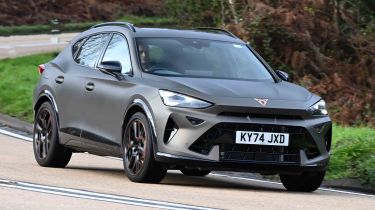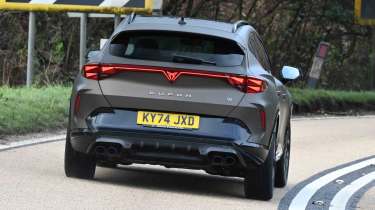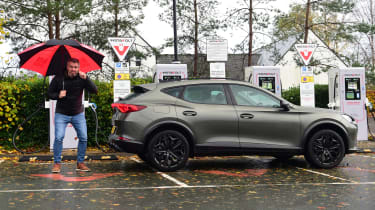Cupra Formentor review
The Cupra Formentor is a sporty, coupe-SUV that’s talented enough to mix it with more established, premium rivals
Is the Cupra Formentor a good car?
The Cupra Formentor has been a real success for the sporty Spanish brand since its launch back in 2020. Its athletic styling and unique copper detailing help it stand out in a crowded compact SUV marketplace that includes mainstream and more premium rivals.
The Formentor has always been good to drive, and there’s a good choice of petrol engines to consider, although the entry 148bhp models feel a little out of kilter with the overall brand ethos. A recent facelift means that the plug-in hybrid models now offer greater efficiency than ever before, while the top-of-the-range, all-wheel-drive versions continue to provide plenty of performance. Refinements to the infotainment system are welcome, although one downside is that some cabin materials aren’t quite at the level you might expect. But if you’re after a practical family car that prioritises the overall driving experience, and offers something a bit different to the SUV norm, then the Formenter is a solid choice.
| Key specs | |
| Fuel type | Petrol, plug-in hybrid |
| Body style | Coupe-SUV |
| Powertrain | 1.5-litre 4-cyl, petrol 1.5-litre 4-cyl, petrol PHEV 2.0-litre 4-cyl, petrol (front or all-wheel drive) |
| Safety | Five stars (Euro NCAP, 2021) |
| Warranty | Five year/90,000 miles |
How much does the Cupra Formentor cost?
The Formentor slots between the Leon hatchback and the Ateca mid-size SUV in the Cupra model lineup, and we’d argue its sleek looks suit the more athletic image of the brand better than the boxlike Ateca. With its lower roofline, the Formentor can’t match the Ateca for headroom or boot space. But the Formentor is still quite long, so it’s a practical car with a decent amount of space in the back, and up to 450 litres of cargo space – provided you pick the right version.
Used - available now

2024 Cupra
Formentor
24,220 milesAutomaticPetrol1.5L
Cash £21,600
2024 Cupra
Formentor
25,552 milesAutomaticPetrol1.5L
Cash £20,287
2024 Cupra
Formentor
42,910 milesAutomaticPetrol1.4L
Cash £19,237
2024 Cupra
Formentor
31,608 milesAutomaticPetrol1.5L
Cash £22,000The range, facelifted in late 2024, starts at around £33,500 for the entry 148bhp 1.5-litre petrol car with a six-speed manual gearbox, while opting for the seven-speed automatic version costs a £2,000 premium. You’ll need an extra £6,000 on top of that if you’d rather have a plug-in hybrid model, with all these prices applying to cars in the V1 specification. Moving up the range to the V2 and V3 trim levels means you’ll pay around £2,000 and £4,500 extra respectively, with the 201bhp V3 e-Hybrid available for a touch over £46,000.
If you’re after more performance then the VZ-badged side of the Formentor range opens things up further. The 262bhp 2.0-litre model in VZ1 trim kicks things off at around £41,000, through to the 328bhp 2.0-litre all-wheel drive VZ3 model that’s approaching a hefty £52,000.
The engine range offers a decent array of options: the 148bhp 1.5-litre petrol (with either a six-speed manual or a seven-speed automatic transmission), and the 201bhp 1.5-litre plug-in hybrid are offered in combination with either the V1, V2, or V3 specifications, while you can have a 262bhp 2.0-litre petrol, a 268bhp 1.5-litre plug-in hybrid or a 328bhp 2.0-litre all-wheel-drive petrol model with any of the VZ1, VZ2 or VZ3 trim levels. Cupra is also offering a First Edition trim with the higher-powered PHEV. All Formentors are front-wheel drive with the exception of the top-of-the-range 2.0-litre model.
Company car drivers may be interested in the 201bhp or 268bhp e-Hybrid versions, both of which use a six-speed automatic and an electric motor. Whereas the pre-facelifted PHEV models provided around 34 to 37 miles of all-electric range, the latest plug-in hybrids feature a larger 25.8kWh battery and more than 70 miles of emissions-free motoring.
Engines, performance & drive
The Formentor is a decent car to drive whatever version you opt for, but it really comes alive in 328bhp 2.0-litre VZ3 form. Here it’s one of the most exhilarating SUVs you can drive; its sharp steering and impressive body control are standout features, while straight-line performance is tantalisingly close to the mighty VW Golf R. And, like that iconic performance hatch it has the ability to turn up the fun factor on demand, or remain perfectly civilised to pootle around town. Read more about the Cupra Formentor’s engines, performance and drive…
MPG, emissions & running costs
It goes without saying that opting for a Formentor model with more than 300bhp and all-wheel drive means you won’t benefit from the best overall efficiency. Arguably, the sweet spot in terms of performance and fuel economy would be one of the two e-Hybrid versions, but they come with a hefty price premium over the 148bhp 1.5-litre TSI. If you regularly take on longer journeys that exceed the PHEV’s all-electric range, then it might be more cost efficient to stick with the entry pure petrol model. Read more about the Cupra Formentor’s MPG, emissions and running costs…
Interior, design & technology
The Cupra Formentor is a sharp-looking crossover that’s bound to turn heads – especially with the copper-coloured wheels on top-spec VZ3 models. The body creases are defined, and there are sharp LED lights at each end. But despite Cupra being a standalone brand these days, there are still crystal-clear links to SEAT, with the side profile of the Leon and Formentor strikingly similar. Read more about the Cupra Formentor’s interior, design and technology…
Boot space, comfort & practicality
You certainly get much more space in the Cupra Ateca than the Cupra Formentor, which trades some of the Ateca’s practicality for a sleeker, sportier look. Legroom is good and headroom is perfectly fine, and the standard petrol models have a decent-sized boot – but the plug-in hybrids lose a bit of luggage space because the batteries for the hybrid system are located under the boot floor. Read more about the Cupra Formentor boot space, comfort and practicality…
Reliability & safety
We lived with a pre-facelift Formentor 1.5 TSI V1 model, covering more than 20,000 miles in the process. Aside from a glitchy infotainment system it hardly put a foot wrong - and that included a trip to a local SEAT dealer for its first service. We said at the time that if you’re after practicality, comfort, the right sort of kit and acceptable performance then the Formentor should definitely be on your shortlist. Read more about the Cupra Formentor’s reliability and safety…
Cupra Formentor alternatives
Key rivals come from upmarket manufacturers such as the Mercedes GLA, Audi Q2 and BMW X2, as well as some other coupe-SUVs like the Peugeot 408 and Renault Arkana. All trade heavily on their individual kerb appeal, so the Formentor continues to have its work cut out, luring customers away from these established marques.
Cupra Formentor VZN long-term test
Our deputy editor Richard Ingram ran a pre-facelift version of the range-topping 306bhp Cupra Formentor VZN as part of our long-term fleet. Although Richard is usually a strong advocate for electric cars, he has enjoyed the engaging driving experience and sporty exhaust sound that this family-friendly SUV provides.
This hasn’t been enough to lure him back towards combustion power, though, as the Cupra has quite a big appetite for fuel. Richard has only managed to achieve an average economy of 31mpg, and this has dipped as low as 18mpg on short journeys. You can read the full long term test here...
Frequently Asked Questions
The Cupra Formentor is good to drive, with strong performance and a suitably high-tech interior. Cabin quality is sound, but there are some materials that don’t quite come to scratch.










